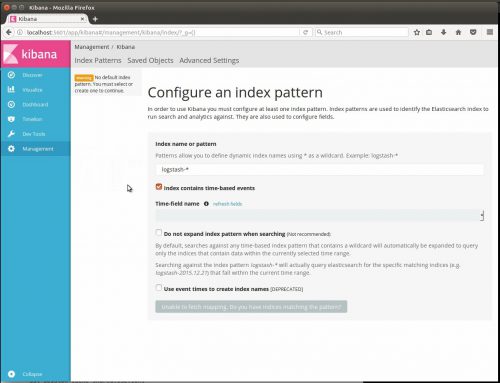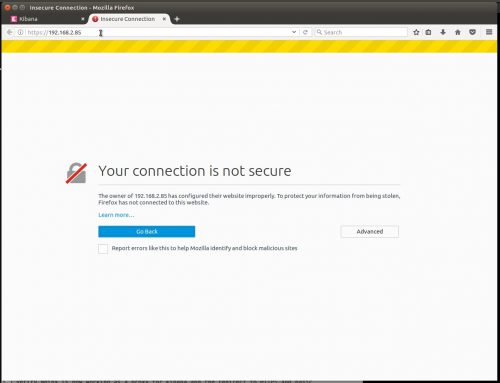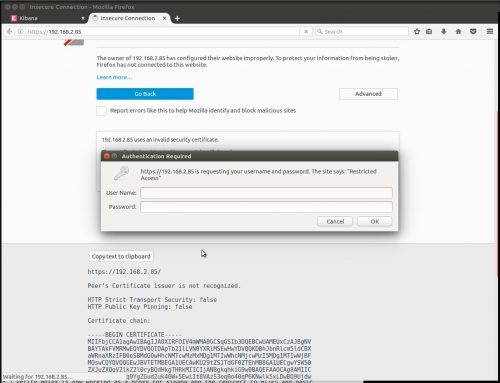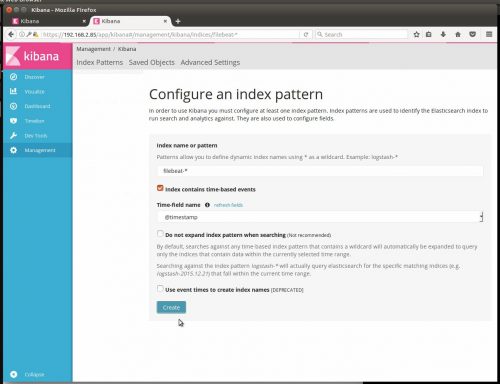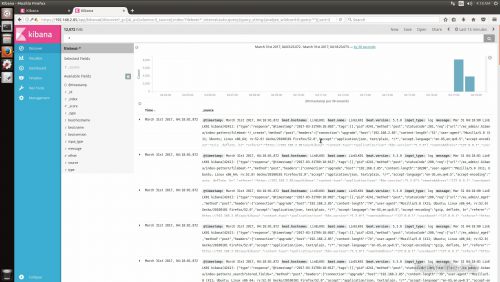In part one of this series, I went over the basics of installing and configuring Ubuntu 16.04. Now in this part, I am going to take that same VM and go over everything needed to create a functional ELK stack on a single server. By the end of this post the ELK stack will be up and ready for use while receiving logs from itself.
Here is the quick run down of exactly what is going to be covered in this post:
- Adding the Elastic and Java repositories to the distro
- Installing Java 8
- Creating a self-signed certificate for use with Nginx
- Installing and configuring Elasticsearch, Logstash & Kibana
- Installing and configuring Nginx as a reverse proxy to sit in front of Kibana with HTTPS and basic authentication
- Installing and configuring Filebeat to collect logs from the local ELK server
The third and final post in this series covers collecting logs from remote Windows clients and can be found here:
ELK 5 on Ubuntu: Pt. 3 – Installing and Configuring Beats Agents on Windows Clients
Preparing the Server for the Installs
1.) Add the Elastic repository to Ubuntu:
rob@LinELK01:~$ sudo wget -qO – https://artifacts.elastic.co/GPG-KEY-elasticsearch | sudo apt-key add –
rob@LinELK01:~$ sudo echo “deb https://artifacts.elastic.co/packages/5.x/apt stable main” | sudo tee -a /etc/apt/sources.list.d/elastic-5.x.list
Reference: https://www.elastic.co/guide/en/beats/libbeat/current/setup-repositories.html
2.) Add the Java 8 repository to Ubuntu:
rob@LinELK01:~$ sudo add-apt-repository -y ppa:webupd8team/java
3.) Run apt-get update:
rob@LinELK01:~$ sudo apt-get update
4.) Install Java:
rob@LinELK01:~$ sudo apt-get -y install oracle-java8-installer
5.) We will need an SSL certificate later for Nginx, so let’s create a self-signed certificate now. First create the directories for the private key and certificate:
rob@LinELK01:~$ sudo mkdir -p /etc/pki/tls/certs
rob@LinELK01:~$ sudo mkdir /etc/pki/tls/private
6.) Open the openSSL configuration file:
rob@LinELK01:~$ sudo nano /etc/ssl/openssl.cnf
7.) Find the [ v3_ca ] section and add the following line to enable the generation of a self-signed certificate tied to an IP address:
subjectAltName = IP: 192.168.2.85
Change the IP: <address> to the IP of the ELK server.
8.) Generate the certificate and key:
rob@LinELK01:~$ cd /etc/pki/tls
rob@LinELK01:~$ sudo openssl req -config /etc/ssl/openssl.cnf -x509 -days 3650 -batch -nodes -newkey rsa:4096 -keyout private/ELK-Stack.key -out certs/ELK-Stack.crt
Installing Elasticsearch
1.) Install Elasticsearch:
rob@LinELK01:~$ sudo apt-get -y install elasticsearch
2.) Open the elasticsearch.yml configuration file:
rob@LinELK01:~$ sudo nano /etc/elasticsearch/elasticsearch.yml
3.) Uncomment/edit the following line to lock access down to the localhost:
network.host: localhost
4.) Restart the service and enable it to start with the server:
rob@LinELK01:~$ sudo service elasticsearch restart
rob@LinELK01:~$ sudo systemctl enable elasticsearch
5.) Verify Elasticsearch is running:
rob@LinELK01:~$ wget http://localhost:9200/
Output:
--2017-04-13 07:48:53-- http://localhost:9200/ Resolving localhost (localhost)... 127.0.0.1 Connecting to localhost (localhost)|127.0.0.1|:9200... connected. HTTP request sent, awaiting response... 200 OK Length: 327 [application/json] Saving to: вҖҳindex.htmlвҖҷ index.html 100%[===================>] 327 --.-KB/s in 0s 2017-04-13 07:48:53 (11.2 MB/s) - вҖҳindex.htmlвҖҷ saved [327/327]
And then cat the output of the index.html to view the contents:
rob@LinELK01:~$ cat index.html
Output:
{
"name" : "AjnlVN6",
"cluster_name" : "elasticsearch",
"cluster_uuid" : "TyJ6kxwwSXSdiY_oVl80BA",
"version" : {
"number" : "5.3.0",
"build_hash" : "3adb13b",
"build_date" : "2017-03-23T03:31:50.652Z",
"build_snapshot" : false,
"lucene_version" : "6.4.1"
},
"tagline" : "You Know, for Search"
}
Installing Kibana
1.) Install Kibana:
rob@LinELK01:~$ sudo apt-get -y install kibana
2.) Open the kibana.yml configuration file:
rob@LinELK01:~$ sudo nano /etc/kibana/kibana.yml
3.) Uncomment/edit the following line to lock access down to the localhost:
server.host: "localhost"
4.) Restart the service and enable it to start with the server:
rob@LinELK01:~$ sudo service kibana restart
rob@LinELK01:~$ sudo systemctl enable kibana
5.) Verify Kibana is running by browsing to http://localhost:5601/.
Installing Nginx
1.) Install Nginx to be the proxy in front of Kibana and apache2-utils to help create the accounts used with the basic authentication:
rob@LinELK01:~$ sudo apt-get install -y nginx apache2-utils
2.) Create a user account for the basic authentication:
rob@LinELK01:~$ sudo htpasswd -c /etc/nginx/htpasswd.users kibanaadmin
The kibanaadmin portion can be changed to whatever username is desired. After hitting enter, you should then be prompted to create a password for the user.
3.) Next wipe the nginx configuration file and then open it:
rob@LinELK01:~$ sudo truncate -s 0 /etc/nginx/sites-available/default
rob@LinELK01:~$ sudo nano /etc/nginx/sites-available/default
4.) Add the following to the configuration file:
server {
listen 80 default_server; # Listen on port 80
server_name 192.168.2.85; # Bind to the IP address of the server
return 301 https://$server_name$request_uri; # Redirect to 443/SSL
}
server {
listen 443 default ssl; # Listen on 443/SSL
# SSL Certificate, Key and Settings
ssl_certificate /etc/pki/tls/certs/ELK-Stack.crt ;
ssl_certificate_key /etc/pki/tls/private/ELK-Stack.key;
ssl_session_cache shared:SSL:10m;
# Basic authentication using the account created with htpasswd
auth_basic "Restricted Access";
auth_basic_user_file /etc/nginx/htpasswd.users;
location / {
# Proxy settings pointing to the Kibana instance
proxy_pass http://localhost:5601;
proxy_http_version 1.1;
proxy_set_header Upgrade $http_upgrade;
proxy_set_header Connection 'upgrade';
proxy_set_header Host $host;
proxy_cache_bypass $http_upgrade;
}
}
I have also created a zip containing the Nginx default configuration file which can be downloaded here – nginx-sites-available.zip
5.) Restart Nginx and enable it to start with the server:
rob@LinELK01:~$ sudo service nginx restart
rob@LinELK01:~$ sudo systemctl enable nginx
6.) Verify Nginx is now working as a proxy for Kibana and the redirect to HTTPS and basic authentication work by browsing to http://192.168.2.85/.
First we get the warning about the self-signed certificate as expected:
And then the basic authentication prompt:
Installing Logstash
1.) Install Logstash:
rob@LinELK01:~$ sudo apt-get -y install logstash
2.) The next few steps will involve creating the Logstash configuration files in /etc/logstash/conf.d/, I have also created a zip containing all 3 files which can be downloaded here – logstash-conf.d.zip
Manual Method –
Create and open the Beats input configuration file:
rob@LinELK01:~$ sudo nano /etc/logstash/conf.d/02-beats-input.conf
3.) Add the following to the configuration file:
input {
beats {
port => 5044
}
}
4.) Create and open the syslog filter configuration file:
rob@LinELK01:~$ sudo nano /etc/logstash/conf.d/10-syslog-filter.conf
5.) Add the following to the configuration file:
filter {
if [type] == "syslog" {
grok {
match => { "message" => "%{SYSLOGTIMESTAMP:syslog_timestamp} %{SYSLOGHOST:syslog_hostname} %{DATA:syslog_program}(?:\[%{POSINT:syslog_pid}\])?: %{GREEDYDATA:syslog_message}" }
add_field => [ "received_at", "%{@timestamp}" ]
add_field => [ "received_from", "%{host}" ]
}
syslog_pri { }
date {
match => [ "syslog_timestamp", "MMM d HH:mm:ss", "MMM dd HH:mm:ss" ]
}
}
}
6.) Create and open the Elasticsearch output configuration file:
rob@LinELK01:~$ sudo nano /etc/logstash/conf.d/30-elasticsearch-output.conf
7.) Add the following to the configuration file:
output {
elasticsearch {
hosts => ["localhost:9200"]
sniffing => true
manage_template => false
index => "%{[@metadata][beat]}-%{+YYYY.MM.dd}"
document_type => "%{[@metadata][type]}"
}
}
Restart Logstash and enable it to start with the server:
rob@LinELK01:~$ sudo service logstash restart
rob@LinELK01:~$ sudo systemctl enable logstash
8.) Verify the service is running:
rob@LinELK01:~$ systemctl status logstash
The Elk Stack should now be running and ready to receive data.
Installing Filebeat on the ELK server
1.) Install Filebeat:
rob@LinELK01:~$ sudo apt-get install filebeat
2.) Edit the file beat configuration file:
rob@LinELK01:~$ sudo nano /etc/filebeat/filebeat.yml
3.) Edit or add additional paths to log files under the paths: section of the configuration file:
- input_type: log
# Paths that should be crawled and fetched. Glob based paths.
paths:
- /var/log/auth.log
- /var/log/syslog
#- /var/log/*
#- c:\programdata\elasticsearch\logs\*
You can add add more paths by adding an additional dash (-) followed by the path to the log. You can also use wildcards (*) in the paths.
4.) Restart Logstash and enable it to start with the server:
rob@LinELK01:~$ sudo service filebeat restart
rob@LinELK01:~$ sudo systemctl enable filebeat
5.) Go back to Kibana and configure the index pattern for Filebeat:
filebeat-*
And now we are able to search against the filebeat index pattern and view the logs that filebeat is feeding the stack:
The stack is now up and ready to start receiving logs from remote machines which will be covered in the next and final part in this series:
ELK 5 on Ubuntu: Pt. 3 – Installing and Configuring Beats Agents on Windows Clients
